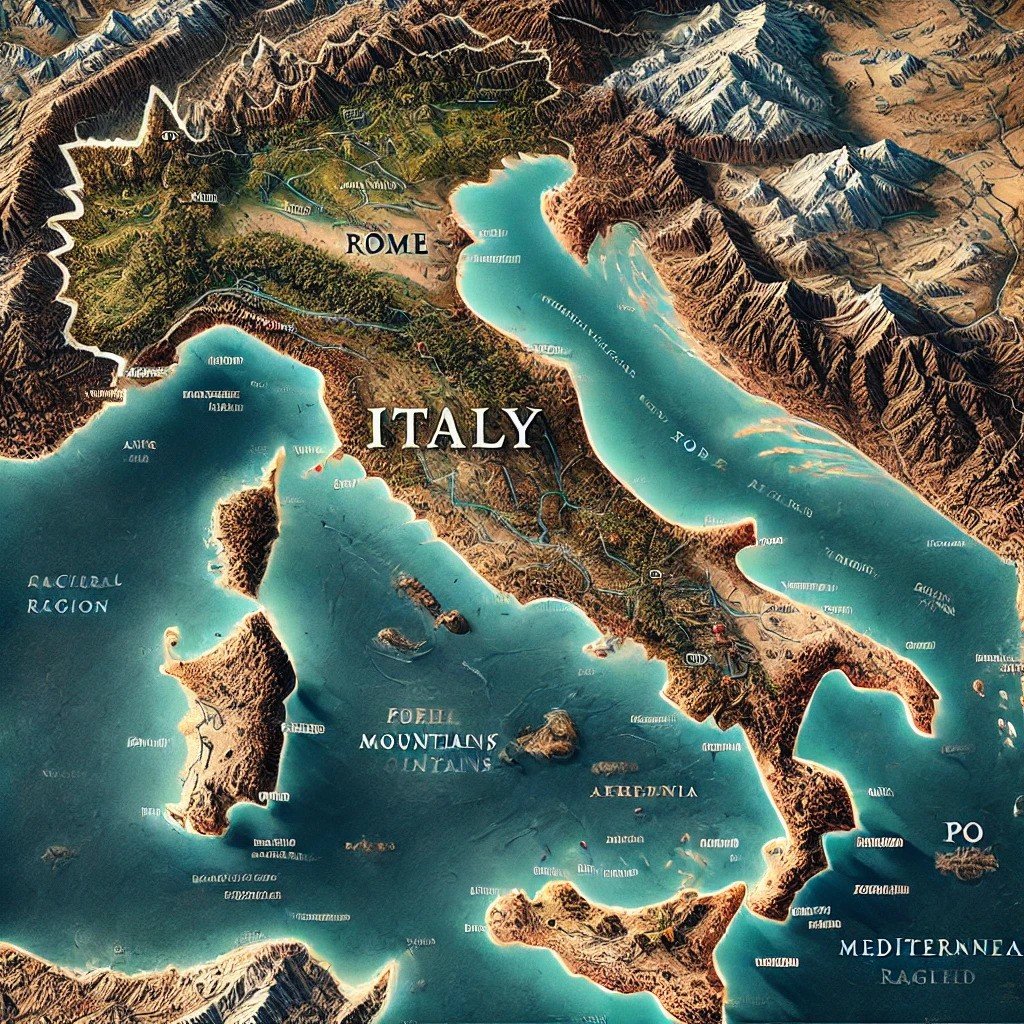Introduction to Italy’s Geography
( map:diwjkmj8_vo= italy ) Italy, a country renowned for its rich history, culture, and stunning landscapes, is located in Southern Europe. Shaped like a boot, this peninsular nation is surrounded by the Mediterranean Sea. This geographical location has significantly influenced its climate, culture, and economy. Exploring Italy through maps offers a unique perspective on its regions, cities, and natural features.
Historical Development of Italian Maps
( map:diwjkmj8_vo= italy ) Throughout history, Italy has been a center for cartography. Ancient Roman maps helped expand the Empire, while Renaissance maps, crafted by Italian cartographers like Fra Mauro, reflected Italy’s growing importance in trade and exploration. The evolution of Italy’s maps over the centuries showcases the shifting boundaries, political entities, and advancements in geographic knowledge.
How visiting these places becomes easier with an eSIM Italy lies in the convenience it offers for staying connected while traveling. From accessing digital maps to uncover ancient trade routes to finding directions to historical landmarks, staying connected ensures a seamless exploration of Italy’s cartographic legacy.
The Italian Peninsula: Physical Geography
( map:diwjkmj8_vo= italy ) Italy is primarily a mountainous country, with the Alps forming its northern boundary and the Apennines running down the spine of the peninsula. These mountain ranges, along with the flat Po River valley, divide the country into distinct geographical regions. Coastal plains and islands like Sicily and Sardinia further add to the complexity of Italy’s physical landscape, as evident in any detailed map.
The Alps and Northern Italy
( map:diwjkmj8_vo= italy ) The Alps dominate northern Italy, forming a natural barrier with neighboring countries such as France, Switzerland, and Austria. Maps of this region often highlight famous mountain passes, ski resorts, and glacial valleys. The northern regions of Piedmont, Lombardy, and Veneto are known for their economic and cultural significance, with cities like Milan and Venice marking prominent locations on the map.
The Po River Valley
( map:diwjkmj8_vo= italy ) The Po River, Italy’s longest river, flows from the Alps and crosses the northern plain, creating one of the most fertile agricultural zones in Europe. Maps of this area emphasize the extensive irrigation systems, farmland, and cities like Turin, Parma, and Bologna. The region is vital for Italy’s agricultural production, particularly rice, wheat, and vineyards.
Central Italy: Tuscany and Beyond
( map:diwjkmj8_vo= italy ) Central Italy is characterized by its rolling hills, historic cities, and vineyards. Tuscany, with its capital Florence, is a focal point on any map of the region. Other notable areas include Umbria and Lazio, where Rome, the capital city of Italy, resides. Maps of central Italy often focus on the region’s artistic heritage, showcasing cities that were instrumental during the Renaissance.
Rome: The Eternal City
( map:diwjkmj8_vo= italy ) As the capital of Italy, Rome is a central feature on any Italian map. The city is home to iconic landmarks such as the Colosseum, Vatican City, and the Roman Forum. Detailed maps of Rome illustrate the intricate network of ancient roads, historic sites, and modern urban development. The Tiber River, which runs through the city, adds another layer to its geographical significance.
The Apennine Mountain Range
( map:diwjkmj8_vo= italy ) The Apennines, often referred to as the “backbone” of Italy, stretch from the north to the south, dividing the country longitudinally. These mountains create natural barriers between regions, impacting both climate and culture. Maps of Italy highlight the winding roads and small towns nestled in the valleys of the Apennines, offering a glimpse into the rural heart of the country.
Southern Italy: Calabria and Basilicata
( map:diwjkmj8_vo= italy ) Southern Italy is a region of contrasts, with mountainous areas, coastal plains, and ancient cities. Calabria and Basilicata are often overlooked, but maps reveal their rich historical and natural importance. The rugged landscape of Calabria, located at the “toe” of Italy’s boot, is reflected in maps showing its steep hills and beautiful coastline along the Tyrrhenian and Ionian Seas.
Sicily: The Island of History and Culture
( map:diwjkmj8_vo= italy ) Sicily, the largest island in the Mediterranean, is a key feature on maps of Italy. Its strategic location has made it a crossroads of civilizations for thousands of years. Maps of Sicily often highlight its volcanoes, particularly Mount Etna, as well as its historic cities like Palermo and Syracuse. The island’s diverse terrain and agricultural abundance are also prominent in geographic representations.
Sardinia: Italy’s Second Major Island
( map:diwjkmj8_vo= italy ) Sardinia, located to the west of the Italian mainland, is another prominent feature on Italian maps. Known for its rugged landscape and clear waters, Sardinia has a distinct cultural identity. Maps often emphasize its coastal areas, popular with tourists, and its mountainous interior, which remains relatively undeveloped.
Italian Coastlines: Amalfi and Liguria
( map:diwjkmj8_vo= italy ) Italy is known for its stunning coastlines, with the Amalfi Coast and the Ligurian Riviera being two of the most famous. Maps of these regions highlight the dramatic cliffs, coastal roads, and small fishing villages that dot the shores. The rugged topography of these areas creates some of the most scenic views in Italy, attracting millions of visitors each year.
Italian Islands Beyond Sicily and Sardinia
( map:diwjkmj8_vo= italy ) Italy also includes several smaller islands that are often overlooked but play important roles in the country’s geography. Islands like Elba, famous for Napoleon’s exile, and the Aeolian Islands, known for their volcanic activity, are prominent on maps focusing on the Mediterranean region. These islands are popular tourist destinations, offering unique landscapes and historical sites.
Volcanic Activity in Italy
( map:diwjkmj8_vo= italy ) Italy is home to some of the most famous volcanoes in the world, including Mount Vesuvius, Mount Etna, and Stromboli. Maps detailing volcanic regions often show the surrounding cities that have been impacted by eruptions, such as Pompeii near Vesuvius. These natural features have shaped the history and development of the surrounding areas.
Italy’s Lakes: Garda, Como, and Maggiore
( map:diwjkmj8_vo= italy ) Northern Italy is also known for its beautiful lakes, particularly Lake Garda, Lake Como, and Lake Maggiore. Maps of these areas highlight their proximity to the Alps and the surrounding towns that have become popular tourist destinations. The lakes are an important part of Italy’s geography, contributing to the region’s climate and economy.
Agriculture and Wine Regions
( map:diwjkmj8_vo= italy ) Italy’s maps often highlight the country’s famous wine regions, such as Chianti in Tuscany and Barolo in Piedmont. These areas, with their rolling vineyards, are central to Italy’s agricultural economy. Detailed maps show the various wine-producing zones, as well as the types of grapes grown in each region.
Urbanization and Major Cities
( map:diwjkmj8_vo= italy ) Italy’s urban landscape is as diverse as its geography. Maps of the country’s major cities, including Milan, Naples, and Florence, reveal the layout of historic centers alongside modern urban development. These maps also emphasize the importance of infrastructure, such as highways, railways, and airports, which connect the cities to the rest of Europe.
Italian Transportation Networks
( map:diwjkmj8_vo= italy ) Italy’s transportation network is crucial for its economy and tourism. Maps of Italy frequently detail the extensive rail system, including high-speed trains like the Frecciarossa, which connects major cities. The country’s highway system, known as the “autostrade,” is also prominent, running from the northern regions to the southern tip of the peninsula.
Tourism and Cultural Maps
( map:diwjkmj8_vo= italy ) Italy is one of the most visited countries in the world, and tourism maps are common. These maps often focus on cultural landmarks, UNESCO World Heritage Sites, and major cities. They guide tourists through Italy’s rich history, from the ruins of Pompeii to the canals of Venice, highlighting important cultural and historical sites.
The Vatican City: A Country Within a City
( map:diwjkmj8_vo= italy ) Although Vatican City is the smallest independent state in the world, it plays a significant role on any map of Rome. As the spiritual center of the Roman Catholic Church, the Vatican is home to St. Peter’s Basilica and the Sistine Chapel. Maps of Vatican City show the compact nature of this independent enclave, surrounded entirely by Rome.
Italy’s Political Divisions: Regions and Provinces
( map:diwjkmj8_vo= italy ) Italy is divided into 20 regions, each with its own unique cultural and geographical identity. Maps of Italy often detail these regions, from the autonomous regions like Sicily and Sardinia to smaller regions such as Molise and Abruzzo. Each region is further divided into provinces, which are also marked on administrative maps.
Italy’s Economic Geography
( map:diwjkmj8_vo= italy ) The economic geography of Italy is diverse, with the northern regions being more industrialized and the southern regions relying more on agriculture and tourism. Maps that focus on Italy’s economy highlight industrial centers like Milan and Turin, as well as agricultural areas in the south. Italy’s position as a key player in European trade is also evident in economic maps showing major ports and transportation routes.
Environmental and Conservation Maps
Italy has a strong focus on environmental conservation, and maps highlighting national parks and protected areas are important for understanding the country’s biodiversity. The Dolomites, Gran Paradiso National Park, and the Aeolian Islands are just a few areas that appear on environmental maps. These regions are crucial for preserving Italy’s natural beauty and ecosystems.
Conclusion: The Importance of Mapping Italy
Maps of Italy offer a comprehensive view of the country’s diverse geography, from its mountainous north to its coastal south. They reflect Italy’s rich history, vibrant culture, and varied landscapes. Whether focusing on physical geography, urban centers, or transportation networks, maps provide a vital tool for understanding Italy’s place in the world.







